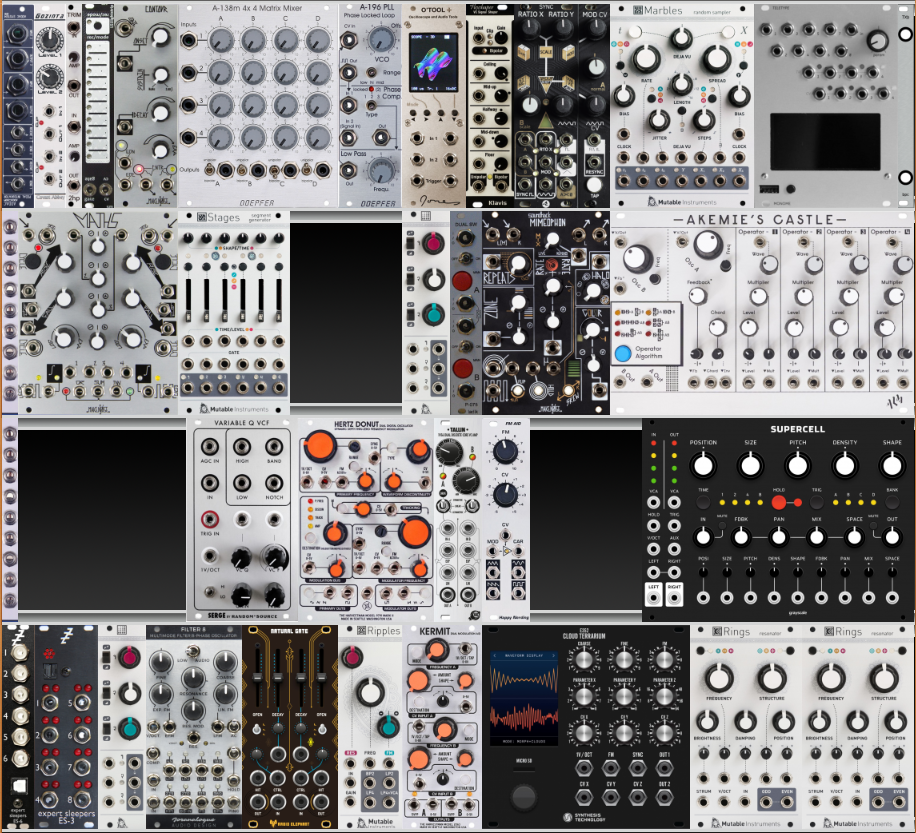I went for that Stages trade, and it should be waiting for me when I get home today. I also rearranged modules one more time, in a layout that is my best compromise between ergononics, balancing the power load between the upper and lower sections, a few signal flow considerations, and not having to move things much in my planned changes.

The second Stages will go beside the first one. E520 will take over the right side of the second row from the bottom, where Supercell and the gap are. Supercell will get sold and replaced with a Typhoon that goes in the gap on the left. That leaves just 5HP empty.
I have no plans beyond that, but I acknowledge there will probably be some must-have module in the future that requires selling off one or two lower-priority modules to make some room. Contour might be one of them; the way I use and approach envelopes has changed, and my “favorite” envelope module isn’t getting as much use. Stages can do everything I like about Contour and far beyond, though with a little more cognitive load.
As I wrote on the subject elsewhere, I’m not really using a lot of envelopes overall, anymore. I used to feel like I needed at least two per voice — one for the output VCA/LPG, one for timbral modulation — but that was when I sequenced everything in MIDI. Contour’s ARSR envelope complimented LPGs with a lowish sustain level, varying gate lengths in a sequence and legato playing and note jumps, which was very much a thing I did a lot of before I got more into the “Starthief sound.” But now, most of my modular voices have their levels manually controlled, with level parameters in Bitwig serving as VCA/mixer. For my sequenced/algorithmic voices I have tended toward simple ASR, AR or R envelopes from Maths or Stages, or even generating R envelopes directly in Teletype, or just triggering R envelopes in Natural Gate, or triggering individual grains in Clouds, or purely gating a source but letting a resonator/delay/reverb provide the envelope naturally…
Stages’ envelopes can get fun, though. You’re not limited to classic envelope types, and you can loop it and hybridize it with a step sequence or other modulation sources. Why ADSR when you can A(LFO)(A/D)(S&H)(A/D)R?
I’ve decided to run with the “castle” theme for the next album, and name each song after a different fictional or mythical castle. Most likely, a few tracks that don’t feature Akemie’s Castle will get titles without “castle” in them, e.g. “Minas Tirith” or “Valaskjálf” or whatever.
Only two recordings done for it so far, but I also submitted two for the next Ambient Online compilation, did two “Feedback February” recordings (one again for a compilation), a couple other recordings I decided weren’t going anywhere, and some experimentation. It’s funny how that feels slow to me now, because sometimes I spend as much as a couple of days without recording anything.
Kraftwerk is touring this summer, on their 50th anniversary. (Hey, I’m almost 50 myself. That felt weird to write.) They’re actually playing in St. Louis, so of course I’ll go.
Kraftwerk has pretty much been a Kraftwerk cover/tribute band for the last several years. They’re down to one original member (after a falling-out and creative meltdown) and three touring musicians, playing on laptops and iPads. They don’t do analog synths anymore. But I still expect to enjoy the show, as I enjoyed the Kraftwerk covers that a dude played at Knobcon last year, only with more technical wizardry and light show stuff.
Already I feel inclined to listen to Kraftwerk stuff for the rest of my workday…



